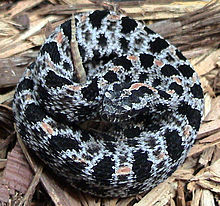| Revision as of 20:13, 6 December 2006 editJwinius (talk | contribs)Autopatrolled, Extended confirmed users23,055 edits Reverted to previous version.← Previous edit | Revision as of 09:31, 11 December 2006 edit undoJoJan (talk | contribs)Autopatrolled, Administrators172,890 edits →Species: - link to Constantine Samuel RafinesqueNext edit → | ||
| Line 43: | Line 43: | ||
| |- | |- | ||
| |'']'' | |'']'' | ||
| |(], ]) | |(], ]) | ||
| |align="center"|2 | |align="center"|2 | ||
| |Massasauga | |Massasauga | ||
Revision as of 09:31, 11 December 2006
| Sistrurus | |
|---|---|

| |
| Western pygmy rattlesnake, Sistrurus miliarius streckeri | |
| Scientific classification | |
| Kingdom: | Animalia |
| Phylum: | Chordata |
| Subphylum: | Vertebrata |
| Class: | Reptilia |
| Order: | Squamata |
| Suborder: | Serpentes |
| Family: | Viperidae |
| Subfamily: | Crotalinae |
| Genus: | Sistrurus Garman, 1884 |
| Synonyms | |
| |
Common names: massasaugas, pigmy rattlesnakes.
Sistrurus is a genus of venomous pit vipers found in Canada, the United States and Mexico. Three species are currently recognized.
Description
Sistrurus species differ from the larger rattlesnakes of the genus Crotalus in a number of ways. They are smaller in size, but also their scalation is different: Sistrurus species have nine large head plates (same as Agkistrodon), whereas with Crotalus (and almost all other viperids) the head is mostly covered with a large number of smaller scales. Sistrurus species have a relatively small rattle that produces more of a high-pitched, buzzing sound than a rattle, like Crotalus.
Geographic range
Found in southeastern Canada, the eastern and northwestern United States, as well as isolated populations in northern and central Mexico.
Venom
Although bites from Sistrurus species are regarded as less dangerous to humans, primarily due to the lower venom yield, every venomous snake bite should be considered serious and prompt medical treatment should always be sought.
Species
| Species | Authority | Subsp.* | Common name | Geographic range |
|---|---|---|---|---|
| S. catenatus | (Rafinesque, 1818) | 2 | Massasauga | North America from southeastern Ontario (Canada) and western New York State southwest to southeastern Arizona (USA) and northern Tamaulipas (Mexico). In Mexico, isolated population exist in southern Nuevo León and north-central Coahuila. It occurs in various habitats ranging from swamps and marshes to grasslands, usually below 1500 m altitude. |
| S. miliarius | (Linnaeus, 1766) | 2 | Pigmy rattlesnake | The southeastern United States from eastern and southern North Carolina southward through peninsular Florida and westward to Oklahoma and eastern Texas. It occurs in flatwoods, sandhills, mixed forests, flood plains and around marshes and lakes. |
| S. ravus | (Cope, 1865) | 2 | Mexican pigmy rattlesnake | The mountains of central and southern Mexico, west of the Isthmus of Tehuantepec, in the southeastern part of the Mexican Plateau, in the highlands of Morelos, Tlaxcala, Puebla, Veracruz, Oaxaca and the Sierra Madre del Sur in Guerrero. |
*) Not including the nominate subspecies (typical form).
) Type species.
See also
- Crotalinae (pit vipers).
- Rattlesnake.
- List of rattlesnake species and subspecies.
- Snakebite.
Cited references
- ^ McDiarmid RW, Campbell JA, Touré T. 1999. Snake Species of the World: A Taxonomic and Geographic Reference, vol. 1. Herpetologists' League. 511 pp. ISBN 1-893777-00-6 (series). ISBN 1-893777-01-4 (volume).
- ^ "Sistrurus". Integrated Taxonomic Information System. 4 November.
{{cite web}}: Check date values in:|date=and|year=/|date=mismatch (help)
External links
- Genus Sistrurus at The Reptile Database
- Sistrurus at Herpbreeder.com. Accessed 26 September 2006.